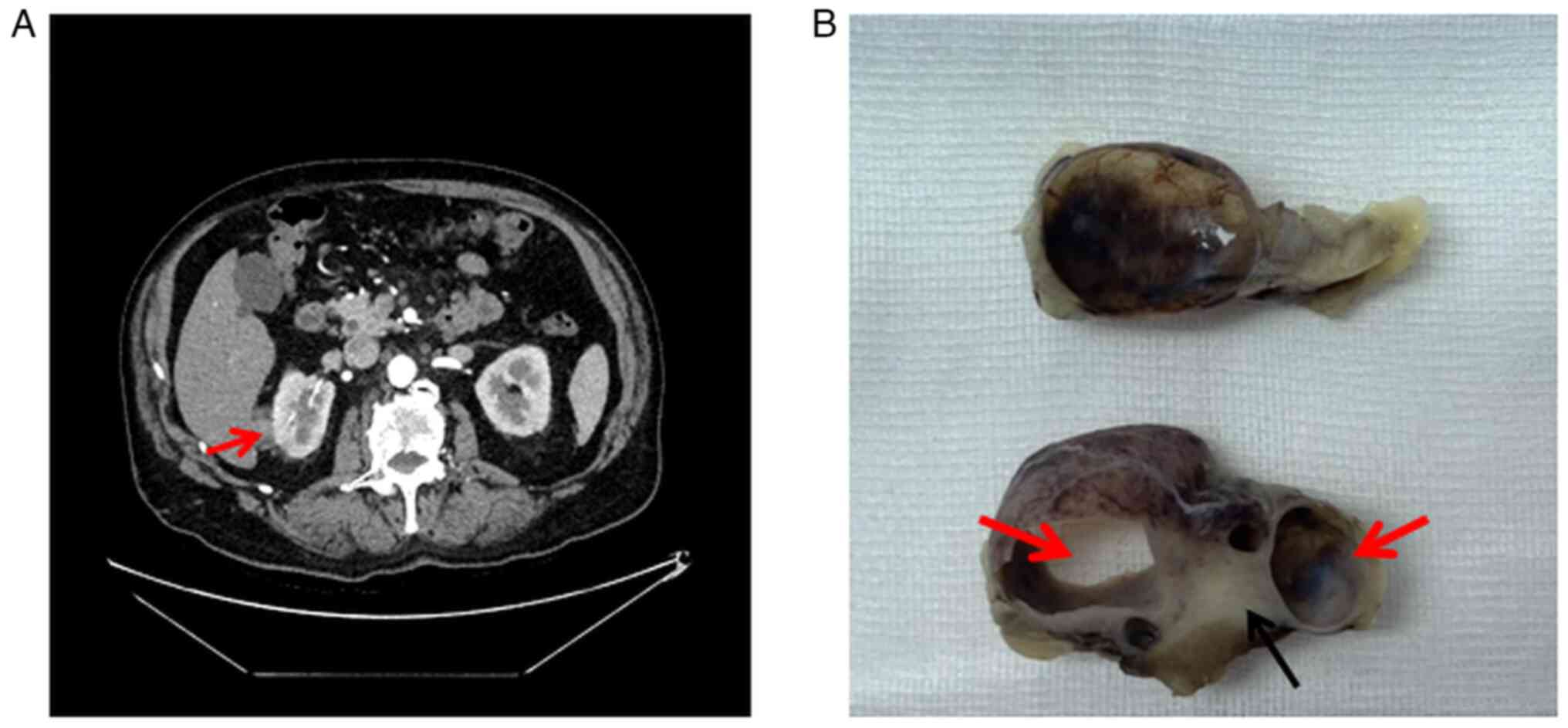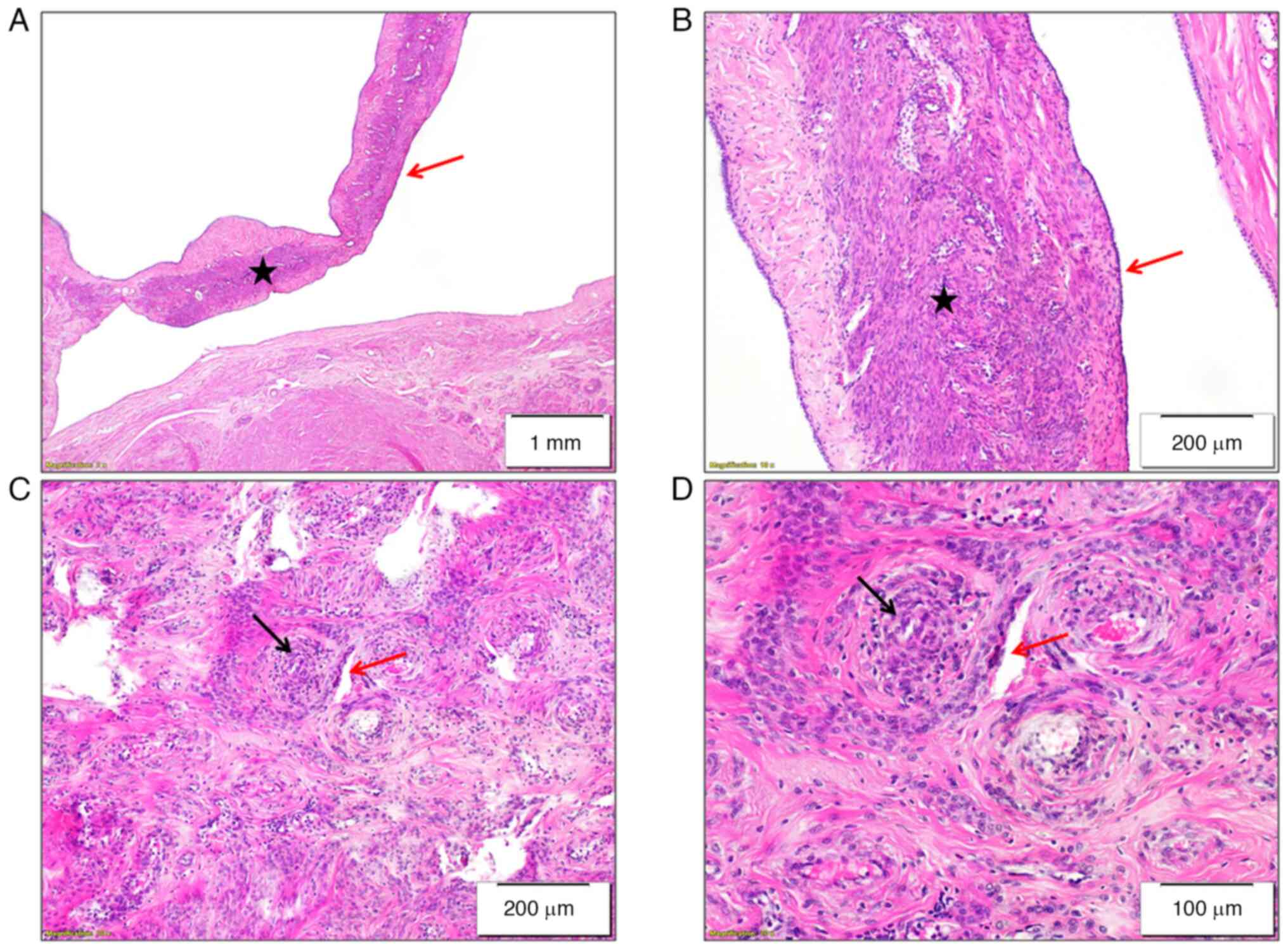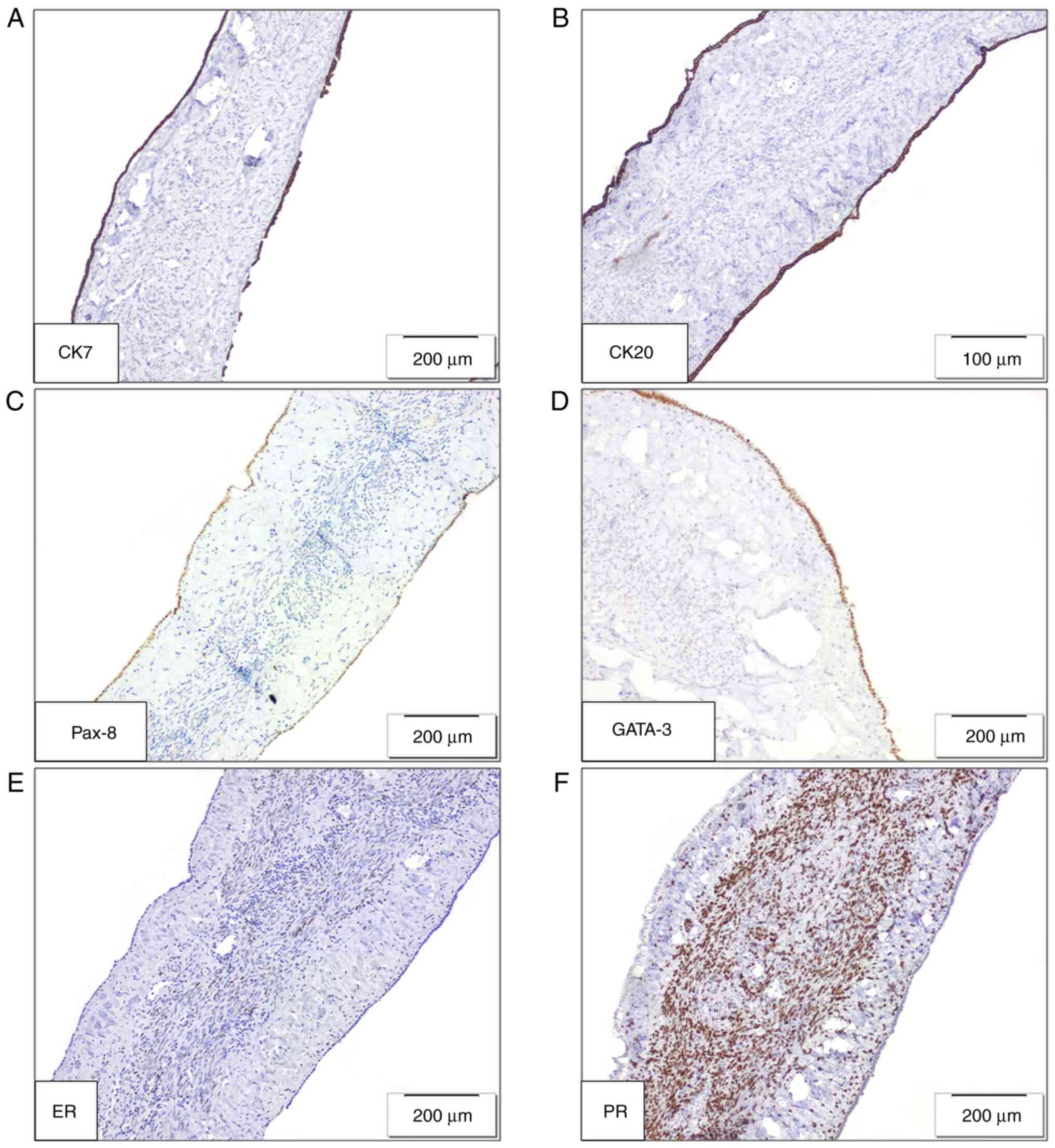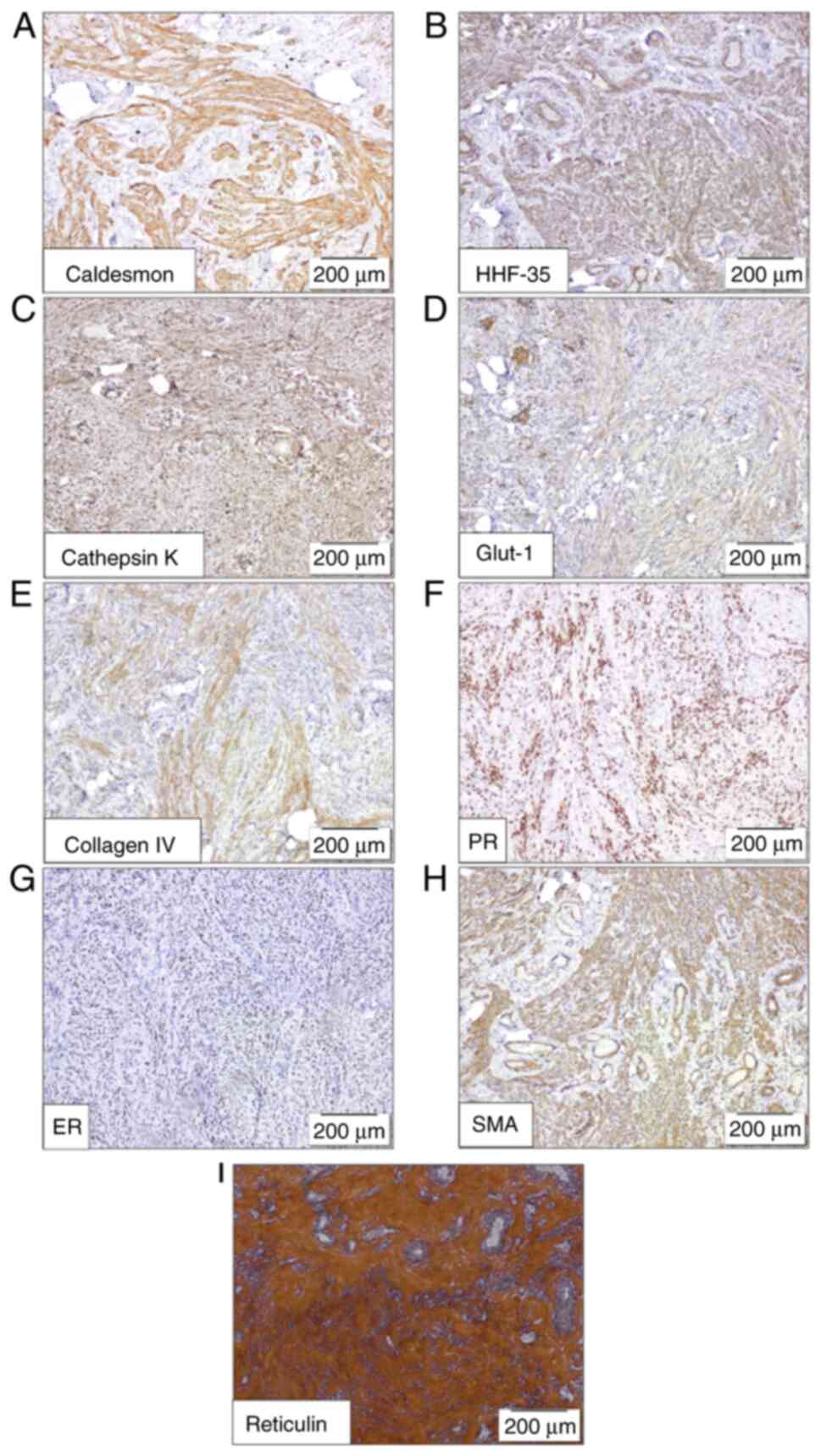Myopericytoma/myofibroma as a stromal component of mixed epithelial and stromal tumor of the kidney: A case report
- Authors:
- Published online on: June 17, 2024 https://doi.org/10.3892/etm.2024.12610
- Article Number: 322
-
Copyright: © Nikolić et al. This is an open access article distributed under the terms of Creative Commons Attribution License.
Abstract
Introduction
A mixed epithelial and stromal tumor (MEST) is a rare neoplasm of the kidney, representing a small fraction of renal tumors, typically occurring in perimenopausal women (female:male ratio, 7:1) (1,2). The exact incidence rate is not well documented due to its rarity. Most of the data on MEST comes from case reports and small case series rather than large epidemiological studies. Research is generally limited to retrospective analyses and case series in the medical literature, describing ~100 cases to date. There are no large-scale registries dedicated to tracking MEST specifically, which makes global incidence rates difficult to determine accurately (1,2).
According to the World Health Organization, MESTs are characterized by a combination of both epithelial cysts and solid component of spindle-shaped cells (3). A number of studies indicate that MESTs are correlated with usage of hormonal therapy both in males and females (4-6). Most cases of MEST are benign, and complete surgical resection is often curative (7,8). However, rare cases of malignant transformation have been reported (4,9,10), with one case reported in a pediatric transplant patient (11), highlighting the importance of close follow-up in patients diagnosed with MEST. The prognosis for MEST is generally favorable, especially in cases where the tumor is completely excised and it demonstrates no evidence of malignancy (3-10).
In the present case report, MEST with myopericytoma/myofibroma as a stromal component is presented, which, according to the best of our knowledge, is the first described case in the literature.
Case report
A 75-year-old male patient was admitted to the Clinic of Urology, University Clinical Center of Serbia (Belgrade, Serbia), in January 2024 for surgery due to the incidental finding of a kidney tumor during an ultrasound scan (USS) of the abdominal cavity, which was performed at a yearly routine check-up. The patient did not have any clinical symptoms or signs of disease. Laboratory findings and urine analysis were within the normal ranges. Kidney function was preserved, and none of the tested tumor marker levels were elevated (Table SI). From the USS, the tumor was described as a nodular mass that was partly cystic and partly solid on the upper pole of the right kidney. On the computed tomography scan (CT), interpolar towards the upper half of the right kidney, a partly solid, partly cystic elongated structure was observed with a maximum diameter of 54 mm along the coronal plane. The soft-tissue component of this structure was opacified by the contrast agent and disrupted the lateral contour of the kidney, and was classified as Bosniak grade IV (Fig. 1A), according to Bosniak Classification of Cystic Renal Masses, Version 2019(12). A partial nephrectomy was performed due to the position of the tumor and accessibility for surgery. On gross section (Fig. 1B), the tumor was 26 mm at the maximal diameter, with a partially cystic and partially solid appearance, as previously seen on CT.
Microscopically, the tumor was composed of cysts lined with a single layer of cuboidal cells, surrounded with ovarian-like stroma. Sharp demarcation between the cystic component and solid component was observed. The solid component of the tumor consisted of bundles of elongated cells with eosinophilic cytoplasm, oval nuclei without atypia and exhibited angiocentric growth. Nuclear atypia and mitoses were not observed. Focally, a ribbon-like hyalinized matrix was present between the cells. The number of small blood vessels was increased, which were small and with slit-like lumina (Fig. 2).
Immunohistochemistry was performed on formalin fixed-paraffin embedded tissue according to the established protocol: Addition of formalin for 24 h at room temperature (RT), 96% ethanol for 24 h at RT, 100% ethanol for 8 h at RT and xylene for 12 h at RT, before paraffin fixation at 52-54˚C for 24 h, and embedding with paraffin at 58˚C. The slides were cut into 4-µm thick sections. Protocols for immunostaining and the list of antibodies are provided in Table SII. All antigen retrieval procedures were performed in an automated manner using Thermo Scientific PT MODULE (Thermo Scientific, Inc.) and DAKO PT Link (Dako; Agilent Technologies, Inc.) for subsequent staining in corresponding automated immunostainers: Thermo Scientific Lab Vision Autostainer 360 [detection system: Epredia-UltraVision Quanto Detection System HRP DAB (REF TL-125-QHD)] and DAKO Autostainer Link 48 [detection system: Agilent Technologies-EnVision FLEX High pH (Link) (REF K8000)]. Moreover, the Ventana BenchMark Ultra was used, as a known closed system containing antigen retrieval procedures (ultraView Universal DAB Detection Kit) and staining steps together. Finally, slides from the automated strainers were removed and dehydrated using 96 and 100% ethanol, xylene and 100% ethanol (1:1), and xylene, and covered with coverslips using Canada balsam.
The epithelial components demonstrated diffuse positive staining for CK7, CK20, Pax-8, GATA-3, estrogen receptor (ER) and progesterone receptor (PR) (Fig. 3). The stromal component demonstrated immunopositivity for Caldesmon, muscle-specific actin (HHF-35), cathepsin K, Glut-1, Collagen IV, PR (diffusely), ER (focally) and smooth muscle actin (SMA) (Fig. 4A-H). Furthermore, histochemical staining demonstrated diffuse positive staining for reticulin, performed using a Reticulin Contrast kit (cat. no. RET-100T; Lot no. RET-163-1/23; BioGnost, Ltd.) according to the manufacturer's instructions (Fig. 4I). A lack of staining was found for desmin, along with a lack of staining for CD34, CD31 and CD99, excluding leiomyoma differentiation (Fig. S1). Finally, the diagnosis of MEST with myopericytoma/myofibroma differentiation of the stromal component was made, based on the specific immunohistochemical findings.
At the time of writing, 4 months after the partial nephrectomy, the patient had recovered completely without any complications. The first postoperative imaging will be performed 6 months after surgery.
Discussion
MESTs of the kidney are rare neoplasms that occur mostly in women (13), and ~25% of known diagnosed MESTs are asymptomatic. Long-term hormonal treatment has been suggested to be involved in MEST development (1-30). In the present case study, the patient was male with no history of hormonal exposure. MESTs are characterized by a combination of both epithelial and stromal elements within the tumor tissue, usually presenting as a well-circumscribed mass, often with a cystic component (15). The histological features of MESTs include epithelial structures such as cysts lined by cuboidal or flat epithelial cells, with ovarian-like stroma between cysts, and a stromal component mostly described as spindle cells resembling leiomyoma (16). Immunohistochemical staining can aid in the diagnosis of MEST, with epithelial components typically positive for CKs, such as CK7 and CK20, and stromal components typically positive for smooth muscle markers, such as SMA and desmin (15).
Karafin et al (19) reported that the epithelium in MESTs highly expresses Pax-2/Pax-8, while generally lacking ER markers. This pattern suggests that the epithelial aspect of MEST might be undergoing a form of renal tubular differentiation, altering its structure and cellular characteristics in tandem with the stromal part of the tumor. The precise nature of this epithelial component, whether it is simply trapped renal tubule cells or an aspect of the malignancy of the tumor remains uncertain. In the present case report, the epithelial component stained positive for Pax-8/Pax-2, but also demonstrated positive staining for ER. Furthermore, the histomorphological characteristics of the stromal component demonstrated myopericyte differentiation, which was immunohistochemically confirmed with the positive staining for SMA, HHF-35, Caldesmon, ER, PR, Glut-1, reticulin and collagen IV, and the negative staining for desmin, CD31, CD34 and CD99.
Angiomyolipoma with epithelial cysts is primarily composed of smooth muscle and lacks notable fat content (19,20); it also features epithelial cysts and contains a combination of solid and cystic structures (21). Therefore, both angiomyolipoma with epithelial cysts and MEST lesions share similar morphological characteristics. However, the presence of melanocytic markers in angiomyolipoma with epithelial cysts (21,22), which are absent in MEST (23), serves as a distinguishing feature between these two types of lesions (19-23).
Cystic nephroma (CN) is another neoplasm that shares similar characteristics with MEST (1,24). In the World Health Organization Classification of Tumors of the Urinary System and Male Genital Organs from 2022, CN in adults is described as subtype of MEST but with distinguishable characteristics, while on the other hand, CN in the pediatric population is classified as a separate entity altogether (1). CN is a predominantly cystic tumor composed entirely of differentiated tissues without solid components (25).
Compared with MEST, CN contains larger cysts, thinner septa and a lower stromal to epithelial ratio (26). Likewise, it has been reported that all CN have mutations in the DICER1 gene, in contrast to MESTs (1). Moreover, the exact etiology of MESTs is unclear, but hormonal factors, as well as obesity, may serve a role in their development (28). However, the present patient had no history of hormone usage or obesity problems.
In conclusion, most cases of MEST are benign and complete surgical resection is often curative. However, rare cases of malignant transformations have been reported, highlighting the importance of close follow-up in patients diagnosed with MEST, particularly those with described transformations, due to the aggressive progression and worse prognosis (18). Finally, considering that, to the best of our knowledge, myopericytoma/myofibroma as a stromal differentiation component in MEST was described for the first time in the present case study, a close follow-up is warranted, since the biological behavior is not well established.
Supplementary Material
Immunohistochemical stains of (A) CD34, (B) CD31, (C) CD99 and (D) desmin were negative in the solid component of the MEST, with an internal positive control for CD34 and CD31 in the endothelium.
Laboratory findings at the time of surgery.
Immunohistochemistry procedure.
Acknowledgements
Not applicable.
Funding
Funding: No funding was received.
Availability of data and materials
The data generated in the present study may be requested from the corresponding author.
Authors' contributions
GN, AM and LS wrote the manuscript. GN, AM, LS, JS, LC, MZ and MJ obtained data and made substantial contributions to the conception and design of the manuscript. GN, VM, LS, JS, LC, JJ and MZ performed the microscopic examination of the tissues, obtained data and made substantial contributions to the interpretation of data. GN, LS, MZ, MJ, JJ and SRS performed the histopathology examination. GN and SRS confirm the authenticity of all the raw data. All authors read and approved the final manuscript.
Ethics approval and consent to participate
The patient provided written informed consent for participation in the case report.
Patient consent for publication
The patient provided written informed consent for the publication of any data and/or accompanying images.
Competing interests
The authors declare that they have no competing interests.
References
|
World Health Organization. Urinary and Male Genital Tumours. In: WHO Classification of Tumours. 5th Edition. Volume 8. International Agency for Research on Cancer, Lyon, 2022. | |
|
Caliò A, Eble JN, Grignon DJ and Delahunt B: Mixed epithelial and stromal tumor of the kidney: A clinicopathologic study of 53 cases. Am J Surg Pathol. 40:1538–1549. 2016.PubMed/NCBI View Article : Google Scholar | |
|
Zhou M and Magi-Galluzzi C: Genitourinary pathology: A volume in the series: Foundations in diagnostic pathology. Elsevier Health Sciences; 2013. | |
|
Adsay NV, Eble JN, Srigley JR, Jones EC and Grignon DJ: Mixed epithelial and stromal tumor of the kidney. Am J Surg Pathol. 24:958–970. 2000.PubMed/NCBI View Article : Google Scholar | |
|
Suzuki T, Hiragata S, Hosaka K, Oyama T, Kuroda N, Hes O and Michal M: Malignant mixed epithelial and stromal tumor of the kidney: Report of the first male case. Int J Urol. 20:448–450. 2013.PubMed/NCBI View Article : Google Scholar | |
|
Zhou M, Kort E, Hoekstra P, Westphal M, Magi-Galluzzi C, Sercia L, Lane B, Rini B, Bukowski R and Teh BT: Adult cystic nephroma and mixed epithelial and stromal tumor of the kidney are the same disease entity: Molecular and histologic evidence. Am J Surg Pathol. 33:72–80. 2009.PubMed/NCBI View Article : Google Scholar | |
|
Sun BL, Abern M, Garzon S and Setty S: Cystic nephroma/mixed epithelial stromal tumor: A benign neoplasm with potential for recurrence. Int J Surg Pathol. 23:238–242. 2015.PubMed/NCBI View Article : Google Scholar | |
|
Zam NA, Lau WK, Yip SK, Cheng CW and Tan PH: Mixed epithelial and stromal tumour (MEST) of the kidney: A clinicopathological report of three cases. Pathology. 41:403–406. 2009.PubMed/NCBI View Article : Google Scholar | |
|
Holkar PS, Jain T, Kavishwar V and Pandya JS: Metastasis in mixed epithelial stromal tumour of the kidney: A rare presentation. BMJ Case Rep. 12(e229293)2019.PubMed/NCBI View Article : Google Scholar | |
|
Dan C, Sahai A, Suri P, Singh J and Trehan RS: Mixed epithelial stromal tumor of the kidney with a mesenteric lymph node: A case report and literature review. Cureus. 27(e46058)2023.PubMed/NCBI View Article : Google Scholar | |
|
Ferdjallah A, Gordon P, Kirankumar V, Dietz K, Bu L and Verghese P: Mixed epithelial and stromal tumor after pediatric kidney transplant. Pediatric Transplant. 23(e13575)2019.PubMed/NCBI View Article : Google Scholar | |
|
Silverman SG, Pedrosa I, Ellis JH, Hindman NM, Schieda N, Smith AD, Remer EM, Shinagare AB, Curci NE, Raman SS, et al: Bosniak classification of cystic renal masses, version 2019: An update proposal and needs assessment. Radiology. 292:475–488. 2019.PubMed/NCBI View Article : Google Scholar | |
|
Baniak N, Barletta JA and Hirsch MS: Key renal neoplasms with a female predominance. Adv Anat Pathol. 28:228–250. 2021.PubMed/NCBI View Article : Google Scholar | |
|
Gokden N, Dawson K and Lindberg M: Malignant rhabdoid tumor arising in a mixed epithelial, stromal tumor of kidney: Report of a male case, review of the literature. Pathol Res Pract. 216(153151)2020.PubMed/NCBI View Article : Google Scholar | |
|
Kalinowski P, Kalinowski T, Kucharz J, Kamecki H, Adamowicz B, Sikora K, Podgórska J and Demkow T: Mixed epithelial and stromal tumor of the kidney: A case report. Oncol Lett. 25:1–5. 2023.PubMed/NCBI View Article : Google Scholar | |
|
Darouichi M, Till JP and Constanthin PE: Renal cystic nephroma: Histologic and immunohistochemical analyses and review of literature. Arch Clin Biomed Res. 3:003–011. 2019. | |
|
Tinguria M and Chorneyko K: Mixed epithelial and stromal tumor: A rare renal neoplasm-case report with clinicopathologic features and review of the literature. Case Rep Pathol. 4(3528377)2023.PubMed/NCBI View Article : Google Scholar | |
|
Caliò A, Cheng L, Martignoni G, Zhang S, Brunelli M and Eble JN: Mixed epithelial and stromal tumours of the kidney with malignant transformation: A clinicopathological study of four cases. Pathology. 54:707–720. 2022.PubMed/NCBI View Article : Google Scholar | |
|
Karafin M, Parwani AV, Netto GJ, Illei PB, Epstein JI, Ladanyi M and Argani P: Diffuse expression of PAX2 and PAX8 in the cystic epithelium of mixed epithelial stromal tumor, angiomyolipoma with epithelial cysts, and primary renal synovial sarcoma: Evidence supporting renal tubular differentiation. Am J Surg Pathol. 35:1264–1273. 2011.PubMed/NCBI View Article : Google Scholar | |
|
Fine SW, Reuter VE, Epstein JI and Argani P: Angiomyolipoma with epithelial cysts (AMLEC): A distinct cystic variant of angiomyolipoma. Am J Surg Pathol. 30:593–599. 2006.PubMed/NCBI View Article : Google Scholar | |
|
Varshney B, Vishwajeet V, Madduri V, Chaudhary GR and Elhence PA: Renal angiomyolipoma with epithelial cyst. Autops Case Rep. 11(e2021308)2021.PubMed/NCBI View Article : Google Scholar | |
|
Fejes Z, Sánta F, Jenei A, Király IE, Varga L and Kuthi L: Angiomyolipoma of the kidney-Clinicopathological analysis of 52 cases. Pathol Oncol Res. 28(1610831)2023.PubMed/NCBI View Article : Google Scholar | |
|
Demır H, Sahın Z, Ozman O, Demırbılek M, Ozden SB, Gurses I, Durak H, Uygun N and Onal B: Mixed epithelial and stromal tumor family of kidney (adult cystic nephroma, mixed epithelial and stromal tumor): Retrospective clinicopathological evaluation. Turk Patoloji Derg. 38:251–260. 2022.PubMed/NCBI View Article : Google Scholar | |
|
Vujanić GM and Đuričić SM: Renal tumours of childhood: A review. Scr Med. 53:337–345. 2022. | |
|
Joshi VV and Beckwith JB: Multilocular cyst of the kidney (cystic nephroma) and cystic, partially differentiated nephroblastoma. Terminology and criteria for diagnosis. Cancer. 64:466–479. 1989.PubMed/NCBI View Article : Google Scholar | |
|
Arshad W, Amir A, Malik MN, Maqbool S, Anwar MI and Lee KY: Rare case of mixed epithelial and stromal tumor (MEST) of the kidney and its diagnostic and therapeutic approach: A case report. Int J Surg Case Rep. 102(107882)2023.PubMed/NCBI View Article : Google Scholar | |
|
Compérat E and Varinot J: Classification of adult renal tumors: An update. Semin Ultrasound CT MR. 38:2–9. 2017.PubMed/NCBI View Article : Google Scholar | |
|
Czarnecka AM, Niedzwiedzka M, Porta C and Szczylik C: Hormone signaling pathways as treatment targets in renal cell cancer (Review). Int J Oncol. 48:2221–2235. 2016.PubMed/NCBI View Article : Google Scholar | |
|
Antic T, Perry KT, Harrison K, Zaytsev P, Pins M, Campbell SC and Picken MM: Mixed epithelial and stromal tumor of the kidney and cystic nephroma share overlapping features: Reappraisal of 15 lesions. Arch Pathol Lab Med. 130:80–85. 2006.PubMed/NCBI View Article : Google Scholar | |
|
Wang Y, Yuan J, Wang J and Fu Q: Mixed epithelial and stromal tumor of the kidney: Report of a rare case and review of literature. Int J Clin Exp Pathol. 8:11772–11775. 2015.PubMed/NCBI |













